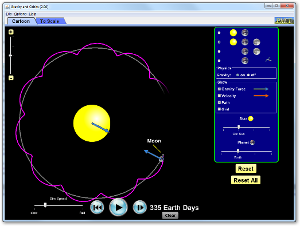[Relevance to CCSS Curriculum – see Modeling]
Finding Neptune:
How Mathematical Modeling Predicted the Location of the Eighth Planet
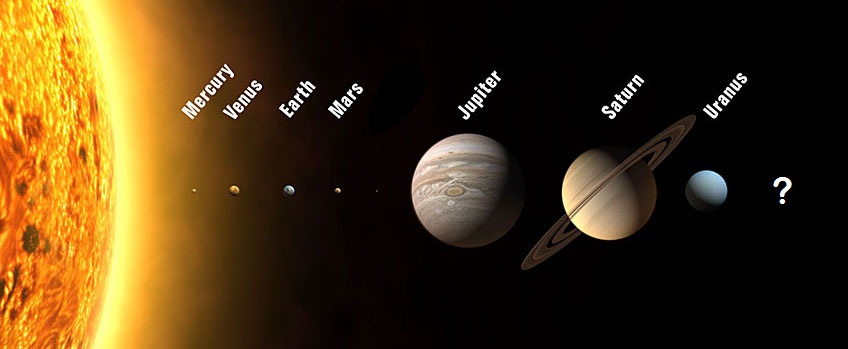
Historical Background
Six of the eight planets – Mercury, Venus, Earth (of course), Mars, Jupiter, and Saturn – have been visible throughout history without the aid of telescopes. Ancient astronomers across the globe noticed how certain lights moved across the night sky relative to the others. The modern term planet is derived from what the Ancient Greeks called these 'moving lights' – planetoi – meaning, "the wanderers." These mysterious 'wandering stars' have been the source of mythical and religious beliefs in many cultures. In fact, we still pay homage to these important solar system bodies in the etymological origins of the days of the week (in many languages).
The theology and intuition that assumed the Earth was at the center of the universe was challenged and replaced by science in the 16th, 17th, and 18th centuries. The heliocentric (Sun-centered) model of the solar system was put forth by Nicolaus Copernicus in 1543. By 1619, Johannes Kepler had sigificantly refined those ideas with mathematical laws which clarified that planets orbited the Sun in predictable elliptical paths (rather than perfectly cicular orbits with epicycles). Galileo Galilei used early telescopes to view evidence for these 'radical' ideas. His subsequent publications led to his famous Inquisition trial in 1633. Planetary motion was more precisely explained in Isaac Newton's 1687 masterwork Principia in which he used gravitational force as the framework.
In the year 1781, the brother and sister astronomer team, William and Caroline Herschel, found the seventh planet, Uranus, by looking through one of the many telescopes they constructed themselves.

William & Caroline Herschel discovered Uranus in 1781.
Telescope replica (7 ft. long, 6 in. diameter)
Over many years of observation, there were several astronomers who recorded the position of the not-yet-official eighth planet in their notes (Galileo-1612, Lalande-1795, Lamont-1846). Apparently, none of them watched it often enough or carefully enough to recognize it as a planet and considered it just another star.
Two French astronomers, Jean-Baptiste Delambre (in 1792) and Alexis Bouvard (in 1808), took the observations of the known planets and moons, particularly Jupiter and Saturn, and painstakingly calculated by hand their past and future orbital paths.
All of this progress set the stage for one of the most riveting examples of the predictive power of mathematics.
Mathematical Background
Kepler's laws of elliptical motion gave rhyme and reason to the orbits of the planets and their moons. Use this applet to better grasp what he was talking about:
Newton said that gravity was the reason why planets zoom around the Sun and provided mathematical relationships to prove it. To better understand how gravitational force and orbit are affected by the mass and velocity of the objects and the distance between them – explore this applet:
at University of Colorado
The numerical tables from Delambre and Bouvard were used by other astronomers to predict where the planets and moons would be in the night sky so they could study them. But a problem arose. The observed orbit of the seventh planet, Uranus, didn’t line up exactly with the mathematical predictions. Its elliptical orbit was a bit wobbly.
What was causing the discrepancy? There were three hypotheses – either (1) sparse observations limited the accuracy of the orbital table predictions, or (2) Newton’s equation describing gravitational force needed to be adjusted, or (3) something else beyond Uranus was causing 'a disturbance in the force.'
Adams and Le VerrierCould our solar system really have yet another, even more distant eighth planet? British Cambridge student John Couch Adams asked himself that very question and started investigating the issue. His initial research seemed promising, especially after confirming his results with the latest orbital data of Uranus. In October 1845, Adams made several attempts to inform the astronomers at the Cambridge Observatory, but his research didn’t seem to motivate anyone enough to spend time searching for the potential planet.
Unbeknownst to Adams, in June earlier that year, Frenchman Urbain Le Verrier also began devoting time to figure out what was going on with Uranus’ orbit. Le Verrier also published several papers (the latter one on June 1st, 1846) that detailed the perturbations of Uranus and put forth another possible position for the interfering planetary body. He convinced some astronomers at the Paris Observatory to check it out, but their half-hearted search didn't last long.
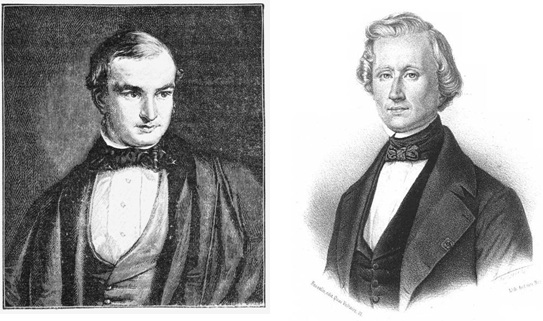
John Couch Adams (1819-1892) Urbain Le Verrier (1811-1877)
These two men were breaking new mathematical ground. Up to this point in time, scientists had been using the work of Kepler and Newton to calculate the gravitational effects between known objects. Instead, Adams and Le Verrier were predicting the approximate orbit, mass, size, and position of a previously unknown object based on its gravitational effects on known objects!
And don't forget that this was all done by hand – no calculator, no computer, just a lot of ink! [Try It: To give you a feel of how time consuming and complicated some of these calculations might have been, open this worksheet to calculate, by hand, what you would weigh on another planet!]
But as confident as they might have been with their analyses, it was still just numbers on paper – not empirical proof.
A Cumulative EffortAdams and Le Verrier apparently weren’t aware of each other’s findings. But one of the astronomers back at Cambridge, George Airy, had read copies of both their work and he realized that their independent predictions coincided amazingly. Less than a week after receiving Le Verrier’s latest paper, Airy had spoken with two prominent astronomers, James Challis and John Herschel, encouraging them to look for an eighth planet. They, and several of their associates, searched for weeks in the appointed area of the sky, but could not verify for sure that one of the many blips of starlight had the motion that would set it apart as a planet. During that time, both Adams and Le Verrier were refining their mathematical analyses to give their respective astronomers even better clues of where to look and what characteristics to look for.
On September 23rd, 1846, a letter sent by Le Verrier was received by German astronomer Johann Galle at the Berlin Royal Observatory. That very night, Galle (and his assistant, Heinrich d’Arrest) pointed a telescope to the area of the most recent prediction spot and, reportedly in less than an hour, found a dot of light absent from previous star charts. They checked the next few nights to make sure it fit the description of a planet – and it did!
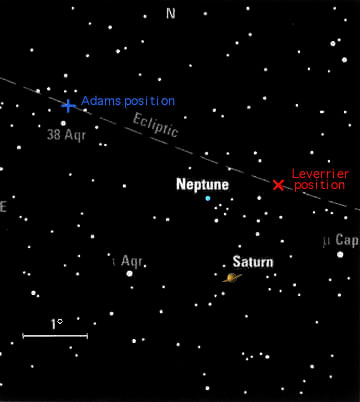
Computer-generated image of the night of discovery
Planet position in star field with predictions
Mathematicians – armed with equations, observational data, and patience (no calculators or computers!) – had guided astronomers' sights to a previously unseen gaseous planet that resides about 30 times farther away from the Sun than Earth (2.8 billion miles / 4.5 billion kilometers) and orbits around at a speed of 5.43 km/sec (nearly 12,000 mph)!
Most sources rightly credit the discovery of Neptune to Le Verrier and Galle. Galle recognized the amazing predictive power of mathematics in a letter response to Le Verrier when he wrote:
“Monsieur, the planet whose place you have computed really exists.”
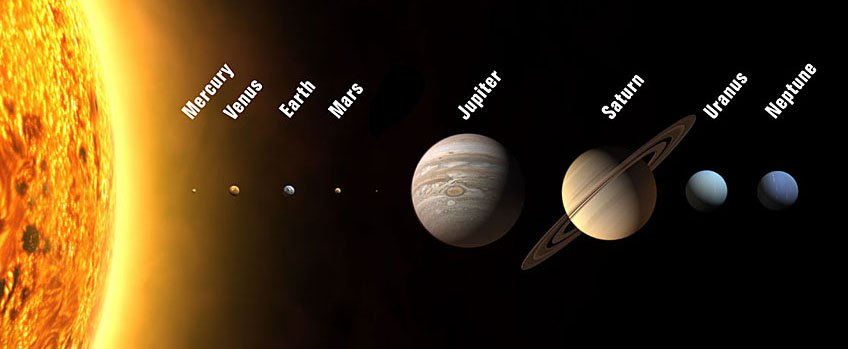
Since Then
Neptune is so distant that it has only orbited the Sun once since its discovery in 1846! It recently past its discovery position in 2011. Check out this one-minute video that shows what has happened here on Earth during Neptune's 165-year trip around the Sun:
Source: Embedded from the HubbleSite-NewsCenter. Video credits to NASA, ESA, and STScI.
[discovery and demotion of Pluto] [incredible findings of hundreds of exoplanets]
Extras
Click here to view a brief recounting of the discovery of Neptune in a lecture by physicist Richard Feynman (view from 2:24-4:00).
To celebrate Johann Galle's 200th birthday and his contributions to astronomy, Google users in central Europe viewed this 'Doodle' on June 9, 2012.
Resources
O'Conner, J. J., & Robertson, E. F. (1996, September). Mathematical discovery of planets. Retrieved from
Gould, Benjamin A. (1850). Report on the History of the Discovery of Neptune. Smithsonian Institution.
Grosser, Morton. (Feb 1979). The Discovery of Neptune. Dover Publications.
Smart, W.M. (Jun 1947). John Couch Adams and the Discovery of Neptune. (Popular Astronomy, Vol. 55, p. 301).
Standage, Tom. (2000 illustrated, digitized 2009). The Neptune file: planet detectives and the discovery of worlds unseen. University of Michigan: Allen Lane
[Back to Teacher Paradise – Math Resources]

